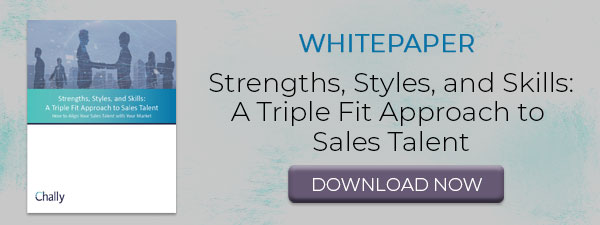The New Normal of Selling: Part 3
Hiring in the New Normal – Onboarding, coaching, and developing sales professionals in the new normal
Welcome to Part 3 of our blog series focused on hiring and retaining salespeople in the post-pandemic world.
Let’s start with a ray of light at the end of a yearlong tunnel: a strong economic growth is expected as we emerge from the COVID-19 pandemic. Economists surveyed by the Federal Reserve Bank of Philadelphia predicts U.S. output will increase 4.5% this year – the biggest bounce since 1999. Likewise, Goldman Sachs predicts super-charged economic growth of 6.8% in 2021 and unemployment dropping to 4.1% by December.[i] “2021 will be a year of near-record economic growth,” according to Leo Feler, Senior Economist, UCLA Anderson Forecast.[ii] Consumers are sitting on a “trillion dollars mountain of cash” and pent-up demand due to pandemic produced savings and Federal stimulus money.[iii] The economic growth is expected to continue beyond this year. Inflation is predicted to remain stable at 2% or less through 2023 with GDP growth averaging 4.5% from 2021 through 2023.[iv]
The opportunities for business development in 2021 appear to be excellent. Indeed, we are already seeing these predictions coming to fruition. Retail spending increased 5.3% in January[v] 2021 and orders for durable goods increased 3.4% in January 2021 as compared to December 2020.[vi] Businesses are starting to invest to meet increasing demand[vii]. With economic growth comes an increased demand for talent, including recruiting salespeople.
Adjusting to the new post-pandemic reality requires us to be prepared for the economic rebound. Both salespeople and sales leaders are pushing to keep the sales environment virtual as things return to normal. Employees are demanding the option to work virtually, and sales leaders have embraced the virtual model for client engagement.[viii] Sales leaders that excel in virtual leadership will develop superior salespeople and win in the marketplace.
In Part II of this series, we shared tips for quickly ramping-up new salespeople and providing ongoing support and growth to develop a superior salesforce. The pivot to a virtual work environment means that sales leaders must adapt how they onboard and coach salespeople. Specifically, sales leaders will need to be more intentional and proactive in connecting with there salespeople. And the content of the conversations needs to be impactful and engaging, fostering trust and two-way communication. Sales leaders who fail to engage their salespeople in meaningful coaching will experience decreased sales outcomes and increased turnover. Virtual coaching requires more structure and purpose and providing salespeople with meaningful, actionable feedback is crucial.
In the previous two blogs in this series, we identified the need to define the different skills required in the new sales context and the power of leveraging an objective online sales assessment to assess candidates and employees. Smart sales leaders leverage information from sales assessments to support onboarding and coaching.
When hiring, we do our best to hire candidates who are the best fit for the job. Unfortunately, no candidate is a perfect fit. All employees have individual strengths and development opportunities.
When onboarding a new salesperson, sales trainers and managers should provide feedback to the new hire from their assessment results to accelerate ramp time and build long-term commitment.
- Identify and leverage strengths: What strengths identified by the assessment align to critical aspects of the job? Reinforce the use of the salesperson’s strengths with the specific parts of the job where there’s an opportunity for the most valuable impact. This may sound obvious, but the salesperson may need guidance on how to best leverage underused strengths in the new and changing sales environment.
- Address development opportunities early: What “watch-outs” did the assessment predict? Where might the watch-out derail the salesperson’s effectiveness? What skills can the salesperson improve to increase their effectiveness? Coach new hires on how to best mitigate the risk and build new skills.
- Create customized professional development plans: Using information learned from the identification of strengths and development opportunities, develop a customized professional development plan for the salesperson with specific goals and metrics. Research shows that providing customized feedback early improves the efficacy of both individual coaching and formal training – leading to increased skill acquisition and application on the job.
- Conduct group needs analysis: Look for trends across groups of new employees. Identify group strengths and development needs identified by the assessment. Leverage the strengths and put a plan in place to mitigate the risk created by the development needs.
For current employees, assessments can be leveraged as an ongoing coaching support tool.
- Refocus skills in the changing environment: As the context of sales shifts, salespeople will need to adjust their behavior to stay effective. Providing feedback, including feedback from assessments, will provide focus in the right areas. Just as you should for a new salesperson, creating a customized professional development plan for existing salespeople is equally beneficial. Ongoing personalized support and guidance will increase effectiveness, engagement and tenure.
- Accelerate career progression: Just as you can leverage assessment data for in role professional development, you can also leverage assessment data to support professional development for a promotion. A good assessment can help you and the salesperson define career pathing. For example, is the high-performing salesperson well-suited for a sales leadership role? Or are they a better fit for a more senior individual contributor sales role? By understanding the best potential fit for future roles, you avoid promotion mistakes and increase long-term success and tenure of high-performing sales talent.
For more tips on coaching a sales team read our blog Sales Coaching: A Guide to Improving Sales Rep Performance.
[i] https://www.nytimes.com/2021/02/21/business/economy/pandemic-economic-boom.html
[iii] https://www.nytimes.com/2021/02/21/business/economy/pandemic-economic-boom.html
[v] https://www.nytimes.com/2021/02/17/business/january-2021-retail-sales.html
[vi] https://www.wsj.com/articles/u-s-durable-goods-climbed-3-4-in-january-11614262261?mod=article_inline
[vii] https://www.wsj.com/articles/u-s-durable-goods-climbed-3-4-in-january-11614262261?mod=article_inline



